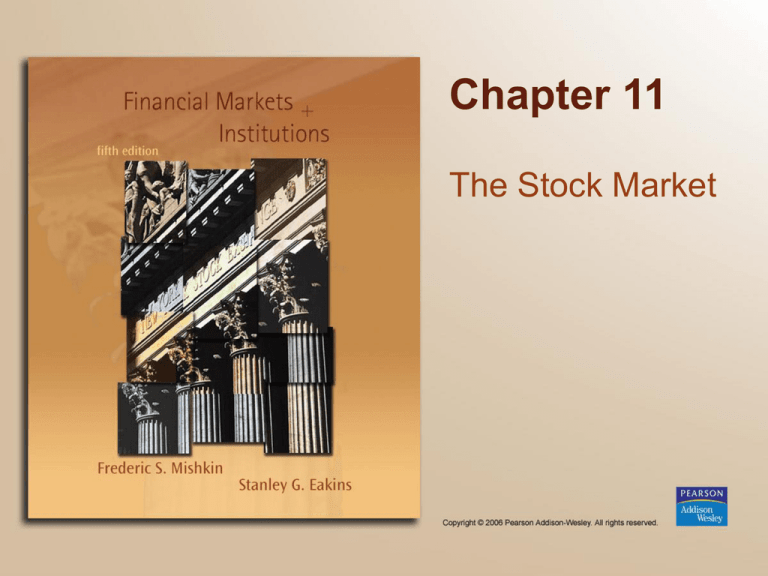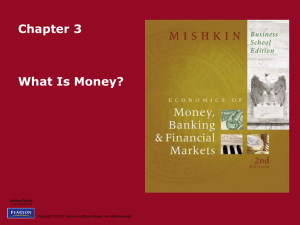
Chapter 11
The Stock Market
Chapter Preview
• We examine the markets where stocks
trade, and then review the underlying
theories for stock valuation. We learn
that stock valuations is quite difficult.
Topics include:
–
–
–
–
Investing in Stocks
Computing the Price of Common Stock
How the Market Sets Security Prices
Errors in Valuation
Copyright © 2006 Pearson Addison-Wesley. All rights reserved.
11-2
Chapter Preview (cont.)
– Stock Market Indexes
– Buying Foreign Stocks
– Regulation of the Stock Market
Copyright © 2006 Pearson Addison-Wesley. All rights reserved.
11-3
Investing in Stocks
1. Represents ownership
in a firm
2. Earn a return in
two ways
4. Right to vote for
directors and on
certain issues
5. Two types
– Price of the stock rises
over time
– Dividends are paid to
the stockholder
– Common stock
3. Stockholders have
claim on all assets
Copyright © 2006 Pearson Addison-Wesley. All rights reserved.
•
•
–
Right to vote
Receive dividends
Preferred stock
•
•
Receive a fixed
dividend
Do not usually vote
11-4
Investing in Stocks:
Sample Corporate Stock Certificate
Figure 11.1 Wien Consolidated Airlines Stock
Copyright © 2006 Pearson Addison-Wesley. All rights reserved.
11-5
Investing in Stocks:
How Stocks are Sold
• Organized exchanges
–
–
–
–
Account for over 72% of total dollar volume
Larges U.S. Exchange is the NYSE
Others include Nikkei, LSE, DAX, etc.
Listing requirements exclude small firms
• Over-the-counter markets
– Best example is NASDAQ
– Dealers stand ready to make a market
Copyright © 2006 Pearson Addison-Wesley. All rights reserved.
11-6
Investing in Stocks:
Organized vs. OTC
• Organized exchanges (e.g., NYSE)
– Auction markets with floor specialists
– 25% of trades are filled directly by specialist
– Remaining trades are filled through SuperDOT
• Over-the-counter markets (e.g., NASDAQ)
– Multiple market makers set bid and ask prices
– Multiple dealers for any given security
Copyright © 2006 Pearson Addison-Wesley. All rights reserved.
11-7
Investing in Stocks: ECNs
ECNs (electronic communication networks)
allow brokers and traders to trade without
the need of the middleman. They provide:
– Transparency: everyone can see
unfilled orders
– Cost reduction: smaller spreads
– Faster execution
– After-hours trading
Copyright © 2006 Pearson Addison-Wesley. All rights reserved.
11-8
Investing in Stocks: ECNs
However, ECNs are not without
their drawbacks:
– Don’t work as well with thinly-traded stocks
– Many ECNs competing for volume, which can
be confusing
– Major exchanges are fighting ECNs, with an
uncertain outcome
Copyright © 2006 Pearson Addison-Wesley. All rights reserved.
11-9
Computing the Price
of Common Stock
Valuing common stock is, in theory, no
different from valuing debt securities:
determine the future cash flows and
discount them to the present at an
appropriate discount rate.
We will review four different methods for
valuing stock, each with its advantages
and drawbacks.
Copyright © 2006 Pearson Addison-Wesley. All rights reserved.
11-10
Computing the Price of Common Stock:
The One-Period Valuation Model
• Simplest model, just taking using the
expected dividend and price over the
next year.
• Price =
Div1
P1
(1 ke ) (1 ke )
Copyright © 2006 Pearson Addison-Wesley. All rights reserved.
11-11
Computing the Price of Common Stock:
The One-Period Valuation Model
What is the price for a stock with an
expected dividend and price next year of
$0.16 and $60, respectively? Use a 12%
discount rate
Answer:
Price =
0.16
60
53.71
(1 0.12) (1 0.12)
Copyright © 2006 Pearson Addison-Wesley. All rights reserved.
11-12
Computing the Price of Common Stock:
The Generalized Dividend Valuation Model
• Most general model, but the infinite sum
may not converge.
Divt
• Price =
t
(
1
k
)
t 1
e
• Rather than worry about computational
problems, we use a simpler version, known
as the Gordon growth model.
Copyright © 2006 Pearson Addison-Wesley. All rights reserved.
11-13
Computing the Price of Common Stock:
The Gordon Growth Model
• Same as the previous model, but it assumes that
dividend grow at a constant rate, g. That is,
Div(t+1) = Divt x (1 + g)
• Price =
Divt
D1
t
( ke g )
t 1 (1 ke )
Copyright © 2006 Pearson Addison-Wesley. All rights reserved.
11-14
Computing the Price of Common Stock:
The Gordon Growth Model
The model is useful, with the
following assumptions:
• Dividends do, indeed, grow at a constant
rate forever
• The growth rate of dividends, g, is less than
the required return on the equity, ke.
Copyright © 2006 Pearson Addison-Wesley. All rights reserved.
11-15
Computing the Price of Common Stock:
The Generalized Dividend Valuation Model
• The price earnings ratio (PE) is a widely
watched measure of much the market is
willing to pay for $1.00 of earnings from
the firms.
P
• Price = E
E
Copyright © 2006 Pearson Addison-Wesley. All rights reserved.
11-16
Computing the Price of Common Stock:
The Price Earnings Valuation Method
If the industry PE ratio for a firm is 16, what
is the current stock price for a firm with
earnings for $1.13 / share?
Answer:
Price = 16 x $1.13 = $18.08
Copyright © 2006 Pearson Addison-Wesley. All rights reserved.
11-17
How the Market Sets Security Prices
• Generally speaking, prices are set in
competitive markets as the price set by the
buyer willing to pay the most for an item.
• The buyer willing to pay the most for an
asset is usually the buyer who can make
the best use of the asset.
• Superior information can play an
important role.
Copyright © 2006 Pearson Addison-Wesley. All rights reserved.
11-18
How the Market Sets Security Prices
• Consider the following three valuations for a
stock with certain dividends but different
perceived risk:
• Bud, who perceives the lowest risk, is willing
to pay the most and will determine the
“market” price.
Copyright © 2006 Pearson Addison-Wesley. All rights reserved.
11-19
Errors in Valuations
Although the pricing models are useful,
market participants frequently encounter
problems in using them. Any of these can
have a significant impact on price in the
Gordon model.
• Problems with Estimating Growth
• Problems with Estimating Risk
• Problems with Forecasting Dividends
Copyright © 2006 Pearson Addison-Wesley. All rights reserved.
11-20
Stock Market Indexes
• Stock market indexes are frequently used
to monitor the behavior of a groups
of stocks.
• Major indexes include the Dow Jones
Industrial Average, the S&P 500, and the
NASDAQ composite.
• The securities that make up the (current)
DJIA are included on the next slide.
Copyright © 2006 Pearson Addison-Wesley. All rights reserved.
11-21
Stock Market Indexes:
the Dow Jones Industrial Average
Copyright © 2006 Pearson Addison-Wesley. All rights reserved.
11-22
Stock Market Indexes
• The next two slides show the Dow Jones
Industrial Average from 1980–2004.
• As can be seen, $1.00 invested in the DJIA
back in 1980, when the DJIA was around
800, would have grown to about $12.50 in
2004, when the Dow reached 10,000. This
represented an annual growth rate
around 10.6%.
Copyright © 2006 Pearson Addison-Wesley. All rights reserved.
11-23
Stock Market Indexes, DJIA
Figure 11.2a Dow Jones Industrial Average, 1980-1989
Copyright © 2006 Pearson Addison-Wesley. All rights reserved.
Historical stocks charts are found at
http://stockcharts.com/charts/historical/
11-24
Stock Market Indexes, DJIA
Figure 11.2b Dow Jones Industrial Average, 1990-2004
Copyright © 2006 Pearson Addison-Wesley. All rights reserved.
Historical stocks charts are found at
http://stockcharts.com/charts/historical/
11-25
Buying Foreign Stocks
• Buying foreign stocks is useful from a
diversification perspective. However, the
purchase may be complicated if the shares
are not traded in the U.S.
• American depository receipts (ADRs) allow
foreign firms to trade on U.S. exchanges,
facilitating their purchase. U.S. banks buy
foreign shares and issue receipts against
the shares in U.S. markets.
Copyright © 2006 Pearson Addison-Wesley. All rights reserved.
11-26
Regulation of the Stock Market
• The primary mission of the SEC is “…to
protect investors and maintain the integrity
of the securities markets.”
• The SEC brings around 500 actions against
individuals and firms each year toward this
effort. This is accomplished through the
joint efforts of four divisions.
Copyright © 2006 Pearson Addison-Wesley. All rights reserved.
11-27
Regulation of the Stock Market:
Divisions of the SEC
• Division of Corporate Finance: responsible
for collecting, reviewing, and making
available all of the documents corporations
and individuals are required to file
• Division of Market Regulation: establishes
and maintains rules for orderly and
efficient markets.
Copyright © 2006 Pearson Addison-Wesley. All rights reserved.
11-28
Regulation of the Stock Market:
Divisions of the SEC
• Division of Investment Management:
oversees and regulates the investment
management industry
• Division of Enforcement: investigates
violations of the rules and regulations
established by the other divisions.
Copyright © 2006 Pearson Addison-Wesley. All rights reserved.
11-29







